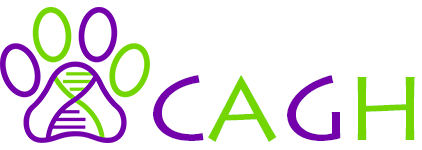Authors Renata Stavinohova (1), Claudia Hartley (1), Louise Burmeister (2), Sally Ricketts (2), Louise Pettitt (2), Roser Tetas Pont (1), Rebekkah Hitti (2), James Oliver (1,2) & Cathryn Mellersh (2)
Affiliations 1. Unit of Comparative Ophthalmology, Centre for Small Animal Studies, Animal Health Trust, United Kingdom, 2. Kennel Club Genetics Centre, Animal Health Trust, United Kingdom
Presentation Type Talk
Abstract
Oculoskeletal dysplasia (OSD) is a hereditary condition in dogs characterised by skeletal and ocular defects. Mutations in collagen genes, COL9A2 and COL9A3, have previously been implicated in the disease in the Samoyed and Labrador retriever breeds respectively. OSD was first observed in the Northern Inuit dog (NID) breed in 2012, with six dogs from two related litters diagnosed. Orthopaedic examinations revealed shortened long bones, hip and elbow dysplasia and osteoarthrosis. Ophthalmic examination revealed multiple ocular defects including macroglobus, cataracts, lens coloboma, retinal detachment and retinal degeneration, resulting in impaired vision. Whole genome sequencing (WGS) was carried out using DNA from two OSD-affected dogs, one of which has been and the other will be shared with the Dog Biomedical Variant Database Consortium (DBVDC). The sequences of nine candidate genes were interrogated for single nucleotide polymorphisms (SNP) and insertions/deletions (indels) by comparing WGS from OSD-affected NID with those from 26 dogs of different breeds without OSD. Twenty-five variants homozygous in both cases but absent from the controls were identified within the candidate genes, and in silico pathogenicity prediction tools excluded 24/25 variants. The remaining variant was predicted to be a nonsense SNP resulting in a premature termination codon and therefore a truncated protein product. This variant was genotyped in a total of 1,233 dogs comprising 123 NID (7 OSD affected, 116 unaffected) and 1,110 dogs of other breeds. All seven OSD-affected NID were homozygous for the mutant allele (T/T), confirming an autosomal recessive mode of inheritance. All 116 OSD-unaffected NIDs were either heterozygous (n=31) or homozygous for the wildtype allele (n=85), confirming that the variant is statistically associated with OSD (Fisher’s exact P-value=1.4×10-11). All 1,110 non-NID dogs were homozygous wildtype. Analysis of the genotypes of NIDs unrelated at the grandparent level resulted in an allele frequency of approximately 8%, suggesting carrier and affection rates of 15% and 0.6% respectively. Analysis of messenger RNA from retinal tissue of an OSD-affected NID and an unaffected golden retriever revealed comparable expression levels, suggesting that the aberrant mRNA does not undergo nonsense-mediated decay. It is likely that a truncated protein product is therefore produced. A DNA test was launched by the AHT in September 2017 and 87 dogs have been tested so far, resulting in the identification of 13 carriers in addition to the 31 carriers identified through the research study.
